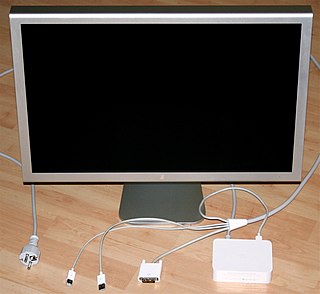Apple Cinema Display
| Apple Cinema Display | ||
|---|---|---|
| overview | ||
| Manufacturer: | Apple Inc. | |
| Publication: | September 1999 | |
| Predecessor: | Apple Studio Display | |
| Successor: | Apple Thunderbolt Display | |
The Cinema Display is a computer screen -Modellreihe the company Apple . The successor is called Thunderbolt Display .
history
The first cinema display was the 22 "acrylic display of the Power Mac G4 , designed by Jonathan Ive , which was released in September 1999. The resolution was 1600 × 1024 pixels. There were two USB ports on the back. The DVI interface was installed up to June 2000 , from July 2000 to January 2003 the ADC connection, which, in addition to the image signal, also provided the power supply for the screen and the USB signal in a cable via a connection.
From March 2002 the Apple Cinema HD display with 23 "and a resolution of 1920 × 1200 pixels, and from January 2003 the 20" display with a resolution of 1680 × 1050 came onto the market. Both in acrylic design, with ADC connection and two USB connections each.
The new flat screens appeared in the summer of 2004 in the new aluminum design of the G5 as 20 ", 23" and 30 "models.
The newer screens are equipped with a DVI interface. A graphics card with a dual link connection is required for the 30 ″ model. Two 30-inch screens can be operated simultaneously on graphics cards with two dual-link outputs.
The 30 ″ Cinema Display has a resolution of 2560 × 1600 pixels (100 ppi ) and was the largest computer screen available when it was first introduced.
The screens also serve as a USB hub and, depending on the model, sometimes also as a FireWire hub. The connections are located on the rear in the lower area.
The connection to the computer and the power supply unit is established via a single cable, which branches out at the end to individual connections for the graphics signal (Mini Display Port or DVI), USB and possibly FireWire and the power supply.
In July 2011, the Apple Thunderbolt Display appeared , replacing the previous series of cinema displays.
criticism
Apple's cinema displays have repeatedly been criticized. The ease of use and the simple connection concept (a cable that includes USB and FireWire as well as the power supply) are countered by the following points of criticism:
- The height of the cinema display is not adjustable. Only the angle of inclination can be changed.
- The device lacks an on / off switch, which means that the device consumes less power even when it is switched off.
- The price for the display was comparatively high. However, the following can be countered: Apple uses relatively high-quality components (for example, pixel errors rarely occur), the aluminum housing is of high quality and is characterized by a special design.
- The display lacks a menu through which the device settings (e.g. color temperature) can be made. Apple's Mac OS X operating system, however, has integrated color management that can be used to indirectly adjust the display.
Power consumption
Apple Cinema Display 24 ″ (aluminum design model end of 2009):
- Operation: 212 watts at maximum power (when charging a MacBook)
- Standby: <1 watt
Apple Cinema HD Display 30 ″:
- Operation: 150 watts at maximum power
- Standby: <3 watts
Apple Cinema HD Display 27 ″:
- Operation: 250 watts at maximum power (when charging a MacBook Pro)
- Standby: <1 watt
See also
- Apple Studio Display (1998-2004)
- Apple Thunderbolt Display (2011-2016)
- Apple Pro Display XDR (2019 – xxxx)
